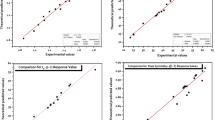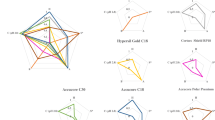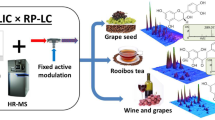Abstract
In the present study, we investigated the possibilities and limitations of computer-assisted method development (CAMD) for the HILIC separation optimization of a mixture of 13 isomeric hydroxy- and aminobenzoic acids on a ZIC-HILIC column. The isocratically obtained Neue and Kuss retention parameters enabled the accurate gradient retention modeling for peaks eluting well within the gradient (mean error of 2.7 %). The prediction errors for peaks eluting at the end of the gradient could be reduced from 8.8 to 6.1 % by implementing the isocratic regime after the gradient into the expression for the gradient retention factor. The prediction of the corresponding peak widths improved significantly for certain compounds and gradient profiles using individual gradient N values for each compound compared to employing a single N value for all compounds and gradient profiles. Two gradient optimization strategies (constructing the R s map based on individual retention modeling and predictive elution stretching and shifting, PEWS2) resulted in a reasonable separation of the challenging mixture of 13 isomeric hydroxy- and aminobenzoic acids on the ZIC-HILIC column. Overall, the optimization was limited by the steep decrease in N (dropping to the isocratic N value) and corresponding increase in peak width when increasing the gradient time. The discrimination factors d 0 were used to assess the resolution between peaks varying widely in height. The best separation was found to be obtained via the PEWS2 approach. Both the individual retention modeling and PEWS2 strategies corresponded to a total instrument time less than 12 h (including equilibration). Finally, it was found that the salt concentration had a significant effect on both the retention and the peak shape of the compounds, resulting in a small “solution domain” at 10 mM. Coupled columns with higher efficiencies are suggested to improve the resolution and robustness of the separation.







Similar content being viewed by others
References
Alpert AJ (1990) J Chromatogr 499:177–196
Kokotou MG, Thomaidis NS (2012) Chromatographia 75:457–467
Périat A, Kohler I, Veuthey J-L, Guillarme D (2013) LCGC Eur 26:17–23
Zhou T, Lucy CA (2010) J Chromatogr A 1217:82–88
McCalley D (2010) J Chromatogr A 1217:3408–3417
Kahsay G, Song H, Van Schepdael A, Cabooter D, Adams E (2014) J Pharm Biomed Anal 87:142–154
Valette JC, Demesmay C, Rocca JL, Verdon E (2004) Chromatographia 59:55–60
Kohler I, Derks RJE, Giera M (2016) LCGC Eur 30:60–75
Duarte RMBO, Duarte AC (2010) J Chromatogr A 1217:7556–7563
Davis JM, Giddings JC (1985) Anal Chem 57:2168–2177
Beinert W, Eckert V, Kgaa M, Galushko S, Tanchuk V, Shishkina I (2001) LC-GC Europe on-line supplementary, pp 34–38
Molnar I (2002) J Chromatogr A 965:175–194
Snyder LR, Dolan JW (1998) Adv Chromatogr 38:115–187
Schoenmakers PJ, Billiet HAH, Tijssen R, De Galan L (1978) J Chromatogr 149:519–537
Neue UD, Mendeze A (2007) J Sep Sci 30:949–963
Baeza-Baeza JJ, Garcia-Alvarez-Coque MC (2014) J Sep Sci 37:2269–2277
Neue UD, Kuss H-J (2010) J Chromatogr A 1217:3794–3803
Tyteca E, Periat A, Rudaz S, Desmet G, Guillarme D (2014) J Chromatogr A 1337:116–127
Tyteca E, Guillarme D, Desmet G (2014) J Chromatogr A 1368:125–131
Noga S, Jandera P, Buszewski B (2013) Chromatographia 76:929–937
Cheng X-D, Peng X-T, Yu Q-W, Yuan B-F, Feng Y-Q (2013) Chromatographia 76:1569–1576
Jandera P (2011) Anal Chim Acta 692:1–25
Skeriková V, Jandera P (2010) J Chromatogr A 1217:7981–7989
Periat A, Debrus B, Rudaz S, Guillarme D (2013) J Chromatogr A 1282:72–83
Guo Y, Srinivasan S, Gaiki S (2007) Chromatographia 66:223–229
Greco G, Grosse S, Letzel T (2012) J Chromatogr A 1235:60–67
Guo Y, Gaiki S (2011) J Chromatogr A 1218:5920
McCalley DV (2007) J Chromatogr A 1171:46–55
Tyteca E, Liekens A, Clicq D, Fanigliulo A, Debrus B, Rudaz S, Guillarme D, Desmet G (2012) Anal Chem 84:7823–7830
El Fallah MZ, Martin M (1987) Chromatographia 24:116–124
Karatapanis AE, Fiamegos YC, Stalikas CD (2011) J Chromatogr A 1218:2871–2879
Baeza-Baeza JJ, Garcia-Alvarez-Coque MC (2014) J Chromatogr A 1022:17–24
Author information
Authors and Affiliations
Corresponding author
Ethics declarations
Funding
Dr. Eva Tyteca was awarded a post-doctoral fellowship from the Research Foundation Flanders (FWO-Vlaanderen).
Conflict of interest
Dr. Eva Tyteca declares that she has no conflict of interest. Stefan Bieber declares that he has no conflict of interest. Prof. Thomas Letzel declares that he has no conflict of interest. Prof. Gert Desmet declares that he has no conflict of interest.
Additional information
Published in the topical collection Young Investigators in Separation Science with editors D. Mangelings, G. Massolini, G. K. E. Scriba, R. M. Smith and A. M. Striegel.
Rights and permissions
About this article
Cite this article
Tyteca, E., Bieber, S., Letzel, T. et al. Possibilities and Limitations of Computer-Assisted Method Development in HILIC: A Case Study. Chromatographia 80, 771–781 (2017). https://doi.org/10.1007/s10337-016-3127-8
Received:
Revised:
Accepted:
Published:
Issue Date:
DOI: https://doi.org/10.1007/s10337-016-3127-8




